
A | B | C | D | E | F | G | H | CH | I | J | K | L | M | N | O | P | Q | R | S | T | U | V | W | X | Y | Z | 0 | 1 | 2 | 3 | 4 | 5 | 6 | 7 | 8 | 9
| Monarchy of Poland | |
|---|---|
 | |
 | |
| Details | |
| Style |
|
| First monarch |
|
| Last monarch | Stanislaus II Augustus |
| Formation | c. 960 (Duchy of Poland) |
| Abolition | 25 November 1795 |
| Residence | |
| Appointer | |
| Pretender(s) |
|
Poland was ruled at various times either by dukes and princes (10th to 14th centuries) or by kings (11th to 18th centuries). During the latter period, a tradition of free election of monarchs made it a uniquely electable position in Europe (16th to 18th centuries).
The first known Polish ruler is Duke Mieszko I, who adopted Christianity under the authority of Rome in the year 966. He was succeeded by his son, Bolesław I the Brave, who greatly expanded the boundaries of the Polish state and ruled as the first king in 1025. The following centuries gave rise to the mighty Piast dynasty, consisting of both kings such as Mieszko II Lambert, Przemysł II or Władysław I the Elbow-high and dukes like Bolesław III Wrymouth. The dynasty's rule over Poland ceased with the death of Casimir III the Great in 1370. In the same year, the Capetian House of Anjou became the ruling house with Louis I as king of both Poland and Hungary. His daughter, Jadwiga, later married Jogaila, the pagan Grand Duke of Lithuania, who in 1386 was baptized and crowned as Władysław II Jagiełło, thus creating the Jagiellonian dynasty and a personal union between Poland and Lithuania.
During the reign of Casimir IV Jagiellon and Sigismund I the Old, culture flourished and cities developed. This era of progress, also known as the Polish Renaissance, continued until the Union of Lublin under Sigismund II Augustus, which unofficially marked the end of the Polish Golden Age. After the death of the last Jagiellonian king, the united Polish–Lithuanian Commonwealth became an elective monarchy with mostly foreigners elected as monarchs such as Henry III of France, who witnessed the introduction of the Golden Liberty system and Stephen Báthory, a capable military commander who strengthened the nation. The meaningful rule of the Vasa dynasty initially expanded the Commonwealth as the arts and crafts developed, as well as trade and commerce. King Sigismund III Vasa, a talented but somewhat despotic ruler, involved the country in many wars, which subsequently resulted in the successful capture of Moscow and the loss of Livonia to Sweden. His son, Władysław IV Vasa, fiercely defended the Commonwealth's borders and continued the policy of his father until his death, unlike John II Casimir whose tragic rule resulted in his abdication.
The election of John III Sobieski to the Polish throne proved to be beneficial for the Commonwealth. A brilliant military tactician, John III led the coalition forces to victory at Vienna in 1683 and he partially recaptured land from the Ottoman Empire. However, the years that followed were not as successful.[4] The long and ineffective rule of the Wettin dynasty (Augustus II the Strong and Augustus III) placed the Commonwealth under the influence of Saxony and the Russian Empire. Additional feuds with rebel nobility (szlachta) and most notably Stanislaus I Leszczyński and France diminished the influence of Poland-Lithuania in the region, which led to the partitions that occurred under King Stanislaus II Augustus, yet another enlightened, but ineffective monarch. The last true sovereign of Poland was Frederick Augustus I as Duke of Warsaw, who throughout his political career attempted to rehabilitate the Polish state. Following the Napoleonic Wars, many sovereigns claimed the title of Polish king, duke or ruler, notably German, Russian and Austrian emperors. The monarchy was abolished and a parliamentary republican authority was established when Poland was re-constituted as a sovereign state in 1918.
Legendary
Most of the legendary Polish rulers appear for the first time in chronicles from the 13th century and their existence has not been determined.
| Name | Portrait | Birth | Marriage(s) | Death | Claim | House |
|---|---|---|---|---|---|---|
| Lech | 
|
Unknown | Unknown | Unknown | Legendary founder of the Polish nation according to folktales, tribal leader | Lechites (Tribe) |
| Krakus I also Krak or Grakch c. 8th century |

|
c. 8th century | Unknown | c. 8th century | Legendary founder of Kraków | Lechites (Tribe) |
| Krakus II c. 8th century |
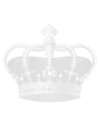
|
c. 8th century Son of Krakus I |
Unknown | c. 8th century | Succession | Lechites (Tribe) |
| Lech II c. 8th century |
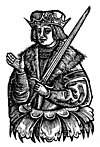
|
c. 8th century Son of Krakus I, brother of Krakus II |
Unknown | c. 8th century | Succession | Lechites (Tribe) |
| Wanda also Wąda c. 8th century |

|
c. 8th century Daughter of Krakus, sister of Krakus II and Lech II |
Unknown | c. 8th century | Succession | Lechites (Tribe) |
| Duke Leszko I also Leszek c. 7th centuries – c. 8th centuries |

|
c. 7th centuries – c. 8th centuries |
Unknown | c. 7th centuries[5] – c. 8th centuries |
Birth name Przemysław, defeated the Hungarians and was crowned Elected |
Goplans and Polans (Tribes) |
| Duke Leszko II c. 8th century |
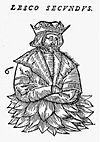
|
c. 8th centuries Presumed son of Leszko I, Alleged progenitor of the Popielids dynasty |
Unknown | c. 8th centuries | Succession | Popielids |
| Duke Leszko III c. 8th century |
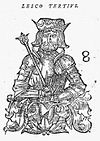
|
c. 8th centuries Presumed son of Leszko II |
Unknown | c. 8th centuries | Succession | Popielids |
| Duke Popiel I c. 8th century |
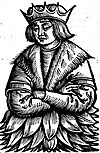
|
c. 8th centuries Presumed son of Leszko III |
Unknown | c. 8th centuries | Succession | Popielids |
| Duke Popiel II c. 9th century |

|
c. 9th century Presumed son of Popiel I |
(1) NN, A German Princess | c. 9th century | A legendary ruler dethroned by Piast. He appears (without the number) in the oldest Polish chronicle, Gesta principum Polonorum from the early 12th century Succession |
Popielids |
| Piast the Wheelwright c. 9th century |

|
c. 9th century Son of Chościsko |
(1) Rzepicha | c. 9th century | Legendary founder of the Piast dynasty. He appears in the oldest Polish chronicle, Gesta principum Polonorum from the early 12th century | Piast |
Semi-legendary
The three direct predecessors of Mieszko I are known only from the account of Gallus Anonymus, who wrote the oldest Polish chronicle, Gesta principum Polonorum at the beginning of the 12th century. Though their historicity was once debatable, now historians tend to consider them actually existing rulers.[6]
| Name | Portrait | Birth | Marriage(s) | Death | Claim | House | Ref. |
|---|---|---|---|---|---|---|---|
| Duke Siemowit also Ziemowit 9th century |

|
9th century Presumed son of Piast the Wheelwright and Rzepicha |
Unknown | 9th century | Named the Duke of the Polans after his father, Piast the Wheelwright, refused to take the place of legendary Duke Popiel Elected |
Piast | [7] |
| Duke Lestek also Leszek or Lestko 9th century – 10th century |

|
c. 870–880 Presumed son of Siemowit |
Unknown | c. 930–950 | Named the Duke of the Polans after succeeding his father Succession |
Piast | [8][9] |
| Duke Siemomysł also Ziemomysł Latin: Zemomislaus 10th century – c. 950/960 |

|
c. 900 Presumed son of Lestek |
Unknown | c. 950–960 | Named the Duke of the Polans after succeeding his father Succession |
Piast | [10] |
House of Piast
| Name | Portrait | Birth | Marriage(s) | Death | Claim | House |
|---|---|---|---|---|---|---|
| Duke Mieszko I Latin: Misico, dux Wandalorum 960 – 25 May 992 (31–32 years) |
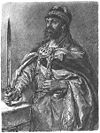
|
c. 930 Son of semi-legendary Siemomysł |
(1) Doubravka of Bohemia c. 965 2 children (2) Oda of Haldensleben c. 980 3 children |
25 May 992 Poznań Aged about 62 |
First Christian ruler of Poland Succession |
Piast |
| King Bolesław I the Brave also Boleslaus I the Great Polish: Bolesław I Chrobry (Wielki) 992–1025 (as duke) 18 April 1025–17 June 1025 (as king) (32–33 years) |

|
c. 967 Poznań Son of Mieszko I and Doubravka of Bohemia |
(1) Hunilda, daughter of Rikdag (2) Judith of Hungary (3) Emnilda of Lusatia (4) Oda of Meissen |
17 June 1025 Kraków Aged about 58 |
First crowned king Succession |
Piast |
| King Mieszko II Lambert 25 December 1025–1031 (5–6 years) |

|
c. 990 Son of Bolesław I the Brave and Emnilda of Lusatia |
(1) Richeza of Lotharingia, 4 children | 10/11 May 1034 Poznań Aged about 44 |
Crowned king Succession Deposed as a result of the Pagan Rebellion |
Piast |
| Duke Bezprym 1031–1032 (0–1 years) |

|
c. 986 Son of Bolesław I the Brave and Judith of Hungary |
Unknown | c. 1032 Aged about 46 |
Country divided, ruler of a Duchy Usurped |
Piast |
| Duke Otto 1032–1033 (0–1 years) |

|
c. 1000 Son of Bolesław I the Brave and Emnilda of Lusatia |
Unknown | c. 1033 Aged about 33 |
Country divided, ruler of a Duchy Usurped |
Piast |
| Duke Dytryk also Dietrich and Theoderick 1032–1033 (0–1 years) |

|
c. 992 Son of Lambert Mieszkowic or Mieszko Mieszkowic |
Unknown | c. 1033 Aged about 41 |
Country divided, ruler of a Duchy Usurped |
Piast |
| Duke Mieszko II Lambert 1033–1034 (0–1 years) |

|
c. 990 Son of Bolesław I the Brave and Emnilda of Lusatia |
(1) Richeza of Lotharingia, 4 children | 10/11 May 1034 Poznań Aged about 44 |
Restored as duke | Piast |
| Duke Bolesław the Forgotten Polish: Bolesław Zapomniany 1034–1038/1039 (4–5 years) |

|
before 1016 Presumed son of Mieszko II Lambert |
Unknown | 1038/1039 | Semi-legendary, existence disputed | Piast |
| Duke Casimir I the Restorer Polish: Kazimierz I Odnowiciel 1034/1040–1058 (17–18 years) |
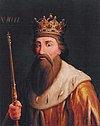
|
25 July 1016 Son of Mieszko II Lambert and Richeza of Lotharingia |
(1) Maria Dobroniega, 5 children | 19 March 1058 Poznań Aged 41 |
Made prince in 1034, returned from abroad in 1040 Restoration |
Piast |
| King Bolesław II the Generous Polish: Bolesław II Szczodry (Śmiały) 1058–1076 (as duke) 26 December 1076–1079 (as king) (20–21 years) |

|
1042 Son of Casimir I the Restorer and Maria Dobroniega |
(1) Wyszesława, 1 son | 2/3 April 1081 Hungary or Ossiach Aged about 39 |
Crowned king in 1076 Deposed and exiled in 1079 after slaying Saint Stanislaus |
Piast |
| Duke Władysław I Herman 1079–4 June 1102 (22–23 years) |

|
1044 Son of Casimir I the Restorer and Maria Dobroniega |
(1) Przecława (2) Judith of Bohemia (3) Judith of Swabia |
24 June 1102 Płock Aged about 58 |
Succeeded brother after his exile | Piast |
| Duke Zbigniew 1102–1107 (4–5 years) |

|
c. 1073 Son of Władysław I Herman and Przecława (?) |
Unknown | 8 July 1113 Aged about 40 |
Succession | Piast |
| Duke Bolesław III Wrymouth also Boleslaus III Polish: Bolesław III Krzywousty 1107–1138 (30–31 years) |

|
20 August 1086 Płock Son of Władysław I Herman and Judith of Bohemia |
(1) Zbyslava of Kiev (2) Salomea of Berg |
28 October 1138 Sochaczew Aged 52 |
Succession His death led to the fragmentation of Poland |
Piast |
Fragmentation of Poland (1138–1320)
| Name | Portrait | Birth | Marriage(s) | Death | Claim | House |
|---|---|---|---|---|---|---|
| High Duke Władysław II the Exile Polish: Władysław II Wygnaniec 1138–1146 (7–8 years) |

|
1105 Kraków Son of Bolesław III Wrymouth and Zbyslava of Kiev |
(1) Agnes of Babenberg, 5 children | 30 May 1159 Altenburg Aged 54 |
Succession Deposed and exiled |
Piast |
| High Duke Bolesław IV the Curly Polish: Bolesław IV Kędzierzawy 1146–1173 (26–27 years) |
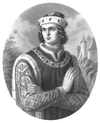
|
c. 1125 Son of Bolesław III Wrymouth and Salomea of Berg |
(1) Viacheslava of Novgorod, 3 children | 5 January 1173 Aged about 51 |
Succeeded exiled half-brother | Piast |
| High Duke Mieszko III Polish: Mieszko III Stary 1173–1177 (3–4 years) |

|
c. 1127 Son of Bolesław III Wrymouth and Salomea of Berg |
(1) Elisabeth of Hungary (2) Eudoxia of Kiev |
13 March 1202 Kalisz Aged about 75 |
Succession Deposed by brother in 1177 |
Piast |
| High Duke Casimir II the Just Polish: Kazimierz II Sprawiedliwy 1177–1190 (12–13 years) |
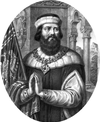
|
c. 1138 Son of Bolesław III Wrymouth and Salomea of Berg |
(1) Helen of Znojmo, 7 children | 5 May 1194 Kraków Aged about 56 |
Usurped power from brother | Piast |
| Mieszko III 1190–1190 |

|
– | – | – | Usurped | Piast |
| Casimir II the Just 1190–1194 |

|
– | – | – | Usurped | Piast |
| High Duke Leszek I the White Polish: Leszek Biały 1194–1198 (3–4 years) |
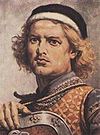
|
c. 1184/1185 Son of Casimir II the Just and Helen of Znojmo |
(1) Grzymisława of Luck, 2 children | 24 November 1227 Marcinkowo Górne Aged about 43 |
Succession | Piast |
| Mieszko III 1198–1199 |

|
– | – | – | Usurped | Piast |
| Leszek I the White 1199–1199 |

|
– | – | – | Restored | Piast |
| Mieszko III 1199–1202 |

|
– | – | – | Usurped | Piast |
| High Duke Władysław III Spindleshanks Polish: Władysław III Laskonogi 1202–1206 (3–4 years) |
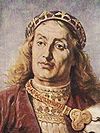
|
c. 1167 Son of Mieszko III and Eudoxia of Kiev |
(1) Lucia of Rügen, 2 children | 3 November 1231 Aged about 64 |
Usurped | Piast |
| Leszek I the White 1206–1210 |

|
– | – | – | Zdroj:https://en.wikipedia.org?pojem=List_of_Polish_monarchs
